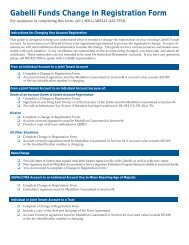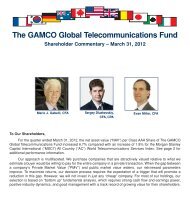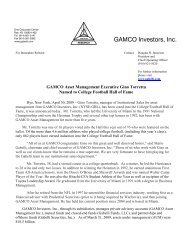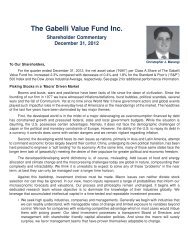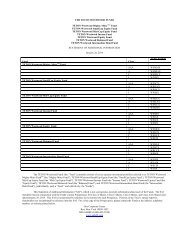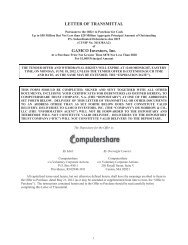The Gabelli Global Telecommunications Fund
The Gabelli Global Telecommunications Fund
The Gabelli Global Telecommunications Fund
Create successful ePaper yourself
Turn your PDF publications into a flip-book with our unique Google optimized e-Paper software.
<strong>The</strong> wild card will be how investors react to any sustained decline in stock prices. A tremendous<br />
amount of money has flowed into the equities market in the last three years. Will it back out at the first<br />
sign of serious trouble It may not be how the great unwashed public reacts, but rather how the great<br />
unwashed professional investors — those twenty and thirty something mutual fund managers who have<br />
never experienced even a substantial market correction — respond to the perceived crisis. Will they see<br />
the glass half empty or half full We don’t know.<br />
While we are dwelling on things on our watch list, we should also mention the strong dollar.<br />
Despite the enormous advances in the quality of American made goods in a wide variety of industries,<br />
the strong dollar will restrain exports and currency translation will have an adverse impact on the<br />
earnings of U.S. based multi-national companies. Longer term, we must also be sensitive to the fact<br />
that substantial cost reductions and productivity gains in American industry over the last five years may<br />
be close to running their course. In other words, profit margins are unlikely to advance further.<br />
We don’t view a market correction as bad news. In general, we are not exposed to those sectors<br />
and individual companies that have benefited most from investor euphoria and which are, therefore,<br />
most vulnerable to a dramatic change in investor sentiment. If anything, a market correction should<br />
provide a more level playing field for disciplined investors focusing on the fundamental value of<br />
individual stocks. We are just now emerging from a two year period in which fundamentals have<br />
mattered much less than market momentum. We are entering what may prove to be an extended<br />
period in which stock pickers excel.<br />
Must Carry<br />
In an upset rivaling the University of Arizona's victory over Kentucky in the 1997 NCAA basketball<br />
championship, the Supreme Court voted 5 to 4 to uphold the “must carry” provision for local broadcast<br />
companies. <strong>The</strong> must carry rule specified that cable television systems must make one-third of their<br />
channel capacity available free to local broadcasters. Led by Ted Turner, the cable television industry<br />
had challenged the rule on the grounds that it violated their first amendment rights. <strong>The</strong> industry’s<br />
economic goal was to free up channel capacity for new cable television networks providing more<br />
popular programming and paying the cable operator for channel space. <strong>The</strong> consensus of the lawyers<br />
on both sides of the issue was the cable guys would win. However, the Supreme Court decided that<br />
allowing cable operators to exclude local broadcast channels would create undue economic hardship<br />
for many broadcasters and threaten the survival of weaker independents.<br />
Who are the winners and losers <strong>The</strong> broadcasters, particularly those with extensive UHF<br />
properties get a renewed lease on life as they maintain and in some cases add to their cable audience.<br />
<strong>The</strong> entrenched cable television networks, like International Family Entertainment, Inc. (FAM -<br />
$20.375 - NYSE), BET Holdings, Inc. (BTV - $29.625 - NYSE), Gaylord Entertainment Company<br />
(GET - $21.50 - NYSE), HSN, Inc. (HSNI - $25.375 - NASDAQ) and Tele-Communications,<br />
Inc./Liberty Media Group (LBTYA - $19.9375 - NASDAQ) benefit because with cable channel capacity<br />
4




